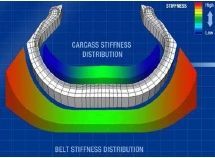You might like to think about the "Tweel" posted by 747. The pressurised air of a conventional tyre is, arguably, replaced by the "spokes" connecting the belt to the wheel rim. The load reacted by the tweel is still contact patch area * average contact patch pressure. Here, however, the "spokes" immediately above the contact patch are buckled, & so cannot contribute significantly to contact patch pressure. So why does the tyre not collapse?xpensive wrote:Conclusively, I will stick to my guns that tyre stiffness is entirely air-pressure dependent, no matter how you cut or slice it.
I would argue that the belt reacts the contact patch pressure directly, the unbuckled spokes act to maintain the basic circular shape of the belt, and the spokes transferring load between the belt the wheel rim are those furthest away from the contact patch.
I am not suggesting that the tweel is a complete analogue for a conventional tyre, but it does, I think, illustrate that more than one mechanism can exist to transfer load across a tyre. It also suggests why, for example, two tyres of the same dimensions on the same rim & same pressure can differ in vertical stiffness by a factor of 2, why some tyres increase stiffness as pressure is reduced, & how a "run flat" tyre might work.






